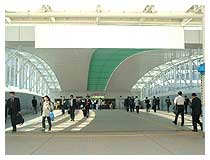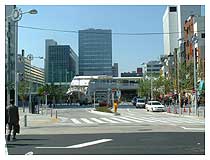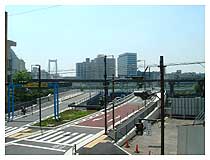Today's Notables
Shibaura Island
July 2004
Hisashi Furuichi
President and C.E.O.
Two years, 3 months have already passed since TK moved from Hamamatsu-cho to its current Tokyo office in Tamachi. At that time, Tamachi station was very old and there was only a narrow walkway from the ticket gate to Shibaura exit stairway. Construction lasted from the time of our move to April 1st of this year. The walkway is 5 times wider than it was before and there are escalators in 3 different directions instead of one stairway. Now there is a rotary area for busses and taxis in front of the station where there was hardly room for taxis. The sidewalks are about 3 times wider so people can walk easily on both sides. Overall the station is about 6 times larger and looks like a brand new residential station building. About 320,000 go through Tamachi station on a daily basis.
Considering the crowding after we moved our office and the inconvenience during the construction, I can understand the necessity of renovating the station with that many people passing through the station. However, that is not the only change in the past two years. From the second floor where the current office is, you can see the Rainbow Bridge and Yokohane freeway along the bay. There is an island between the bay side highway and our office called Shibaura Island. There are two bridges that connect the island to two different beaches and from the day they were completed, more and more people have used them. Today, people are constantly moving from morning until night. And the more that discover a new way to get to work, the more traffic there is.
In the past, section A of Shibaura Island was used to warehouse train cars, then as a place to park busses, and at one time, Shin Mitsui Sugar Co., Ltd. had a factory in the southern section. The total area of the island is about 6 hectares. Section A has been developed by Urban Development Corporation and now there are 6 companies including Mitsui Fudosan Co., Ltd., involved in development in the area. The city's plan to improve the land in the warehousing area took a very long time, however, it is near completion. Now there are plans to develop a 48 floor high rise condominium building and another apartment complex with 4 different buildings and a total of 4,100 apartments. Along with this development, plans for parks, kindergartens, daycare centers, after-school centers and other service organizations are in the works. By 2007, the area will be home to more than 5,000 people.
Recently is seems like condominiums and residences in the city are in better supply than they used to be and there has been a renewal of sorts in downtown areas. According to data, 5,657 residences in 1992 have increased to 31,574 by 2002, or growth of 5.6 times. The borough with the highest population growth is Chuo-ku, followed by Minato-ku. Of course, Tokyo is the world's most populated city and just the 23 boroughs themselves would be in the top 11. The trend toward moving back to the city is a slow and quiet process that is hardly drawing any notice. As long as the capital remains unchanged, the concentration will continue which is cause for concern for other areas outside of Tokyo metropolitian areas.
 |
 |
 |
HOME > What’s New > Today's Notables > Details














